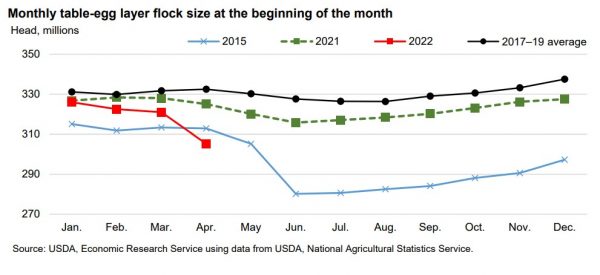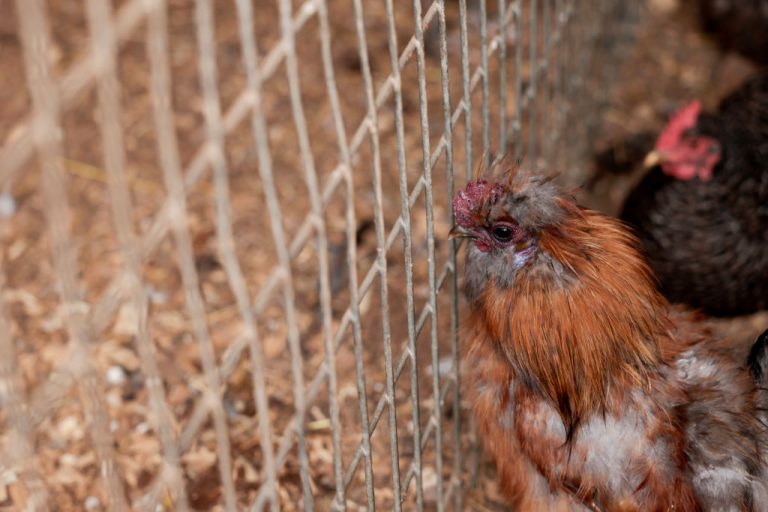The current pandemic of avian influenza ravaging U.S. poultry has sent the country’s flock to its lowest levels since the 2015 pandemic, data from the U.S. Department of Agriculture (USDA) shows.
The USDA’s May of 2022 Livestock, Dairy, and Poultry Outlook publication stated that 37 million commercial birds have been culled as a result of the pandemic, among which were 28.7 million table-laying hens.
2015 is a particularly notable year for the industry, as the USDA notes the 2014-15 season was the last major avian influenza outbreak in the United States.
The 2015 instance lasted from December of 2014 to June of 2015, and resulted in the death of 43 million egg-layers and 7.3 million turkeys, they stated.
The publication noted that the first instance of an outbreak at a table-egg layer facility was Feb. 22 in President Joe Biden’s home state of Delaware.
Success
You are now signed up for our newsletter
Success
Check your email to complete sign up
The publication stated that today’s event is so severe that America lost 8.9 percent of its table-laying flock in February.
44 percent of all slain animals were in Iowa, which the USDA says is the nation’s largest egg producer.
Counting through May 11, the USDA stated that 16.9 million egg producing hens died from avian influenza in March and 10.7 million in April.

A data graph showed that as of the beginning of April, the U.S. egg producer flock was under 310 million, down from slightly less than 330 million in January, which was already down from the 2017-2019 average of slightly more than 330 million.
The sub-310 million mark represents a number lower than what was seen during the same period of the 2015 avian influenza outbreak, which bottomed around 280 million before showing signs of recovery after the pandemic ended and through to the end of the year.
Despite the death of so many birds in March, the USDA noted that somehow, the chickens that survived had picked up the slack in production, “March lay rate averaged 82.7 eggs per 100 layers per day, a 2.4-percent increase from last year and a record high for March.”
As a result of the current avian influenza outbreak, the USDA has downgraded its forecast for 2022 production to 7.688 billion dozen, a decrease of 3.6 percent year over year.
Nonetheless, the USDA remains optimistic, stating it forecasts 2023’s production cycle to produce 8.170 billion dozen eggs.
The current incarnation of avian influenza has taken its toll on producer’s pocketbooks, however, “April wholesale egg prices averaged 272.3 cents per dozen. At a 166-percent year-over-year increase and 40-percent month-over-month increase, the April average prices set a historic high, surpassing the 2015 record-average prices,” the Outlook stated.
The publication stated that wholesale price increases were likely being driven by commercial users such as bakeries, restaurants, and manufacturers switching from broken eggs to shell eggs, the kind usually used in grocery stores.
Data showed that the price of broken eggs had jumped from less than $1 per dozen before March 16 to as high as $2.50 per dozen as of April 9.
Shell eggs, likewise, jumped from a yearly low of $1.50 per dozen to a high of slightly less than $3 over the same period.
But it’s not just farm chickens and turkeys affected by the outbreak. Wildlife is also being hit, and hard. According to May 21 reporting by USA Today affiliate Milwaukee Journal Sentinel, the 2015 avian influenza outbreak only registered 98 avian influenza-positive birds over the course of six months.
By comparison, this year’s instance of the disease has already registered 1,156 cases among wild birds spread across 38 states. North Dakota, North Carolina, and Florida have been hardest hit, with 212, 143, and 108 cases respectively.
















